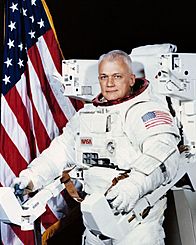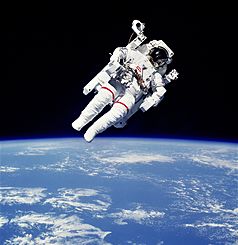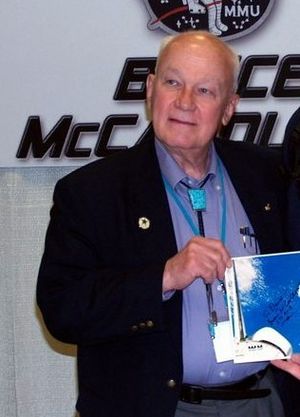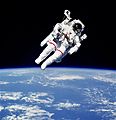Bruce McCandless II facts for kids
Quick facts for kids
Bruce McCandless II
|
|
|---|---|

McCandless in 1971
|
|
| Born |
Byron Willis McCandless
June 8, 1937 Boston, Massachusetts, United States
|
| Died | December 21, 2017 (aged 80) Los Angeles, California, U.S.
|
| Resting place | United States Naval Academy Cemetery |
| Nationality | American |
| Alma mater | USNA, B.S. 1958 Stanford U., M.S. 1965 UHCL, M.B.A. 1987 |
| Occupation | Naval Aviator, engineer |
| Space career | |
| NASA Astronaut | |
| Rank | |
|
Time in space
|
13 days 0 hours 31 minutes |
| Selection | 1966 NASA Group 5 |
|
Total EVAs
|
2 |
|
Total EVA time
|
12 hours 12 minutes |
| Missions | STS-41-B, STS-31 |
|
Mission insignia
|
|
| Retirement | August 31, 1990 |
| Spouse(s) | Bernice Doyle McCandless, Ellen Shields McCandless |
| Children | 2 |
Bruce McCandless II (born Byron Willis McCandless; June 8, 1937 – December 21, 2017) was an American Navy officer, pilot, engineer, and NASA astronaut. He is famous for making the first ever untethered spacewalk in 1984. This means he floated freely in space, not connected to his spacecraft, using a special jetpack called the Manned Maneuvering Unit.
Contents
Early Life and Education
Byron Willis McCandless was born on June 8, 1937, in Boston, Massachusetts. His family had a history of serving in the U.S. Navy. His father, Bruce McCandless, and grandfather, Willis W. Bradley, both received the Medal of Honor for their bravery. When he was young, his mother changed his name to Bruce McCandless II. He finished high school in Long Beach, California, in 1954.
In 1958, he earned a degree in science from the United States Naval Academy. He was one of the top students in his class. Later, he continued his studies, getting a master's degree in electrical engineering from Stanford University in 1965. He also earned a business degree from the University of Houston–Clear Lake in 1987.
After joining the Navy, McCandless trained to become a pilot. He learned to fly at naval air stations in Florida and Texas. In March 1960, he officially became a United States Naval Aviator. He then trained to fly fighter jets and land them on aircraft carriers.
From 1960 to 1964, he flew jets like the Douglas F4D Skyray and the McDonnell Douglas F-4B Phantom II. He served on aircraft carriers like the USS Forrestal and the USS Enterprise. He was even part of the Cuban Missile Crisis events while on the Enterprise.
McCandless also worked as a flight instructor for a short time. He was skilled in flying many different types of aircraft, including various jets and even a helicopter. Overall, he spent more than 5,200 hours flying, with 5,000 hours in jet aircraft.
Becoming a NASA Astronaut
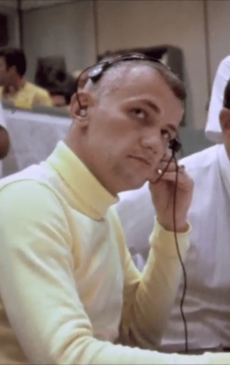
In April 1966, at age 28, Bruce McCandless was chosen to be part of NASA Astronaut Group 5. This group was sometimes called the "Original Nineteen." Because of his strong science background, McCandless and another astronaut, Don L. Lind, were often seen as "scientist-astronauts." This was a bit different from the test pilots NASA usually picked, which meant their journey to space might take longer.
McCandless played an important role on the ground during early space missions. He was a CAPCOM (Capsule Communicator) for Apollo 11. This meant he was the main person talking to the astronauts in space, including Neil Armstrong and Buzz Aldrin during their historic first moonwalk. He also helped with the Apollo 14 mission.
Later, he worked on the Skylab program, which involved an early space station. He was a backup pilot for the first crewed Skylab mission. He also helped develop the Manned Maneuvering Unit (MMU), which was a special jetpack for spacewalks. Even though he could have been a Shuttle pilot, he chose to focus on the MMU as a mission specialist. This was because the MMU program was very important and would guarantee him a flight into space.
McCandless also helped develop equipment and plans for other major space projects. These included the Hubble Space Telescope and the International Space Station. In total, he spent over 312 hours in space, including four hours flying the MMU. He flew on two Space Shuttle missions: STS-41-B and STS-31.
STS-41-B: The First Untethered Spacewalk
The Space Shuttle Challenger launched on February 3, 1984. This mission was very important because it was the first time the MMU jetpack was tested in space.
During this mission, Bruce McCandless made history. He became the first person to float freely in space without being connected to the spacecraft. He used the MMU to move around, completely untethered. His first spacewalk lasted for 6 hours and 17 minutes. Another astronaut, Robert L. Stewart, also used the MMU during a second spacewalk on this mission.
After eight days in orbit, the Challenger landed safely back at the Kennedy Space Center.
STS-31: Deploying Hubble
On April 24, 1990, McCandless flew on his second Space Shuttle mission, STS-31, aboard the Discovery. This five-day flight had a very important goal: to deploy the Hubble Space Telescope. The crew released Hubble from a record-setting altitude of 380 miles (610 km) above Earth.
During the deployment, one of Hubble's solar panels got stuck. McCandless and fellow Mission Specialist Kathryn D. Sullivan got ready for a possible spacewalk to fix it. Luckily, ground control was able to get the panel to unfurl, so the spacewalk wasn't needed.
The Discovery landed on April 29, 1990, at Edwards Air Force Base in California.
After NASA
After retiring from NASA in 1990, Bruce McCandless worked for Lockheed Martin Space Systems, a company that builds spacecraft.
Organizations and Awards
McCandless was a member of several important organizations related to space and engineering:
- United States Naval Academy Alumni Association
- United States Naval Institute
- Institute of Electrical and Electronics Engineers (IEEE)
- American Institute of Aeronautics and Astronautics (AIAA)
- Association for Computing Machinery
- National Audubon Society
He was also honored with many awards for his service and achievements:
- NASA Exceptional Service Medal (1974)
- National Defense Service Medal (1974)
- Armed Forces Expeditionary Medal (1974)
- NASA Space Flight Medal (1984)
- Defense Distinguished Service Medal (1985)
- NASA Exceptional Engineering Achievement Medal (1985)
- Collier Trophy (1984)
- National Air and Space Museum Trophy (1985)
- Legion of Merit (1988)
- International Space Hall of Fame (1995)
- United States Astronaut Hall of Fame (2005)
He even received a patent for designing a system to keep tools attached during spacewalks.
Personal Life
Bruce McCandless was married to Bernice Doyle McCandless for 53 years. They had two children, Bruce III and Tracy. His hobbies included electronics, photography, scuba diving, and flying. He also enjoyed cross-country skiing.
In an interview, McCandless once said that the best part about his famous untethered spacewalk photo was that you couldn't see his face. He felt it made the image represent all of mankind, not just him.
In 2010, McCandless was involved in a legal matter with singer Dido because she used his famous spacewalk photo on her album cover without permission. The issue was settled peacefully.
Bruce McCandless passed away on December 21, 2017, at the age of 80. He was buried at the United States Naval Academy Cemetery. His son, Bruce McCandless III, later wrote a book about his father's incredible journey to make the first untethered spacewalk.
See also
 In Spanish: Bruce McCandless II para niños
In Spanish: Bruce McCandless II para niños
Images for kids


